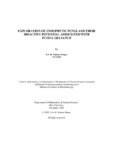| dc.contributor.advisor | Hossain, Dr. M. Mahboob | |
| dc.contributor.author | Haque, S.A.M. Salman | |
| dc.date.accessioned | 2023-08-09T05:56:17Z | |
| dc.date.available | 2023-08-09T05:56:17Z | |
| dc.date.copyright | 2022 | |
| dc.date.issued | 2022-12 | |
| dc.identifier.other | ID: 19176006 | |
| dc.identifier.uri | http://hdl.handle.net/10361/19368 | |
| dc.description | This thesis report is submitted in partial fulfillment of the requirement for the degree of Master of Science in Biotechnology, 2022. | en_US |
| dc.description | Cataloged from PDF version of thesis. | |
| dc.description | Includes bibliographical references (pages 109-114). | |
| dc.description.abstract | Endophytic fungi are a group of fungi that reside in the living plant without causing any
symptoms. It shows symbiotic/mutualistic characteristics with host plants. Endophytic fungi
may increase the host defense system against various pathogenic microorganism and contains
secondary metabolites of the respective host plant. Isolation of endophytic fungi and it’s
metabolites from Punica Granatum plant grown in Bangladesh is a recent and new approach.
A total of six endophytic fungi were isolated and purified from the leaf and bark part of the
plant. All of the isolated endophytic fungi namely DgB1, DgB3, DgL3, and DgL4 were
identified up to genus level based on macroscopic and microscopic characteristics and up to
species level based on molecular characteristics as Diaporthe pseudomangiferae, Diaporthe
pseudomangiferae, Phomopsis tersa, and Colletotrichum siamense respectively. Preliminary
chemical screening of the fungal extracts by thin layer chromatographic technique revealed the
presence of various compounds such as flavonoids, anthraquinones, couramins, isocoumarins
etc. An antimicrobial study was carried out against a wide range of both Gram-positive and
Gram-negative bacteria by disc diffusion method, and testing of the antioxidant property was
done by following DPPH scavenging method. Fungal strain DgL4 showed significant
antioxidant activity of 21.08 µg/ml and DgB1 showed moderate antimicrobial activity. The
extract DgL3 was later purified by solvent treatment with mixtures of n-Hexane, DCM, and
methanol. Structural elucidation of the isolated compound was done through their spectral data
(NMR). Overall, these findings indicate that the medicinal plants of Bangladesh and their
associated endophytic fungi could be an ideal target for the discovery of potentially bioactive
compounds or lead structures for new drugs. | en_US |
| dc.description.statementofresponsibility | S.A.M. Salman Haque | |
| dc.format.extent | 114 pages | |
| dc.language.iso | en | en_US |
| dc.publisher | Brac University | en_US |
| dc.rights | Brac University theses are protected by copyright. They may be viewed from this source for any purpose, but reproduction or distribution in any format is prohibited without written permission. | |
| dc.subject | Endophytic fungi | en_US |
| dc.subject | Pomegranate | en_US |
| dc.subject | Antioxidity | en_US |
| dc.subject | Fungal strains | en_US |
| dc.subject | Fungal extracts | en_US |
| dc.subject.lcsh | Pomegranate. | |
| dc.subject.lcsh | Medicinal plants. | |
| dc.title | Exploration of endophytic fungi and their bioactive potential associated with Punica Granatum | en_US |
| dc.type | Thesis | en_US |
| dc.contributor.department | Department of Mathematics and Natural Sciences, Brac University | |
| dc.description.degree | M. Biotechnology | |

